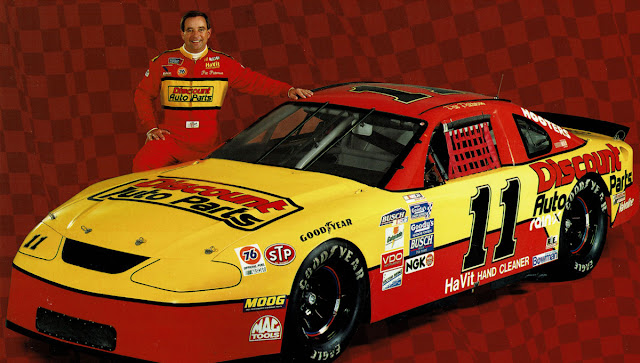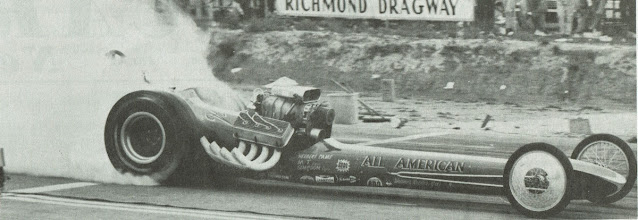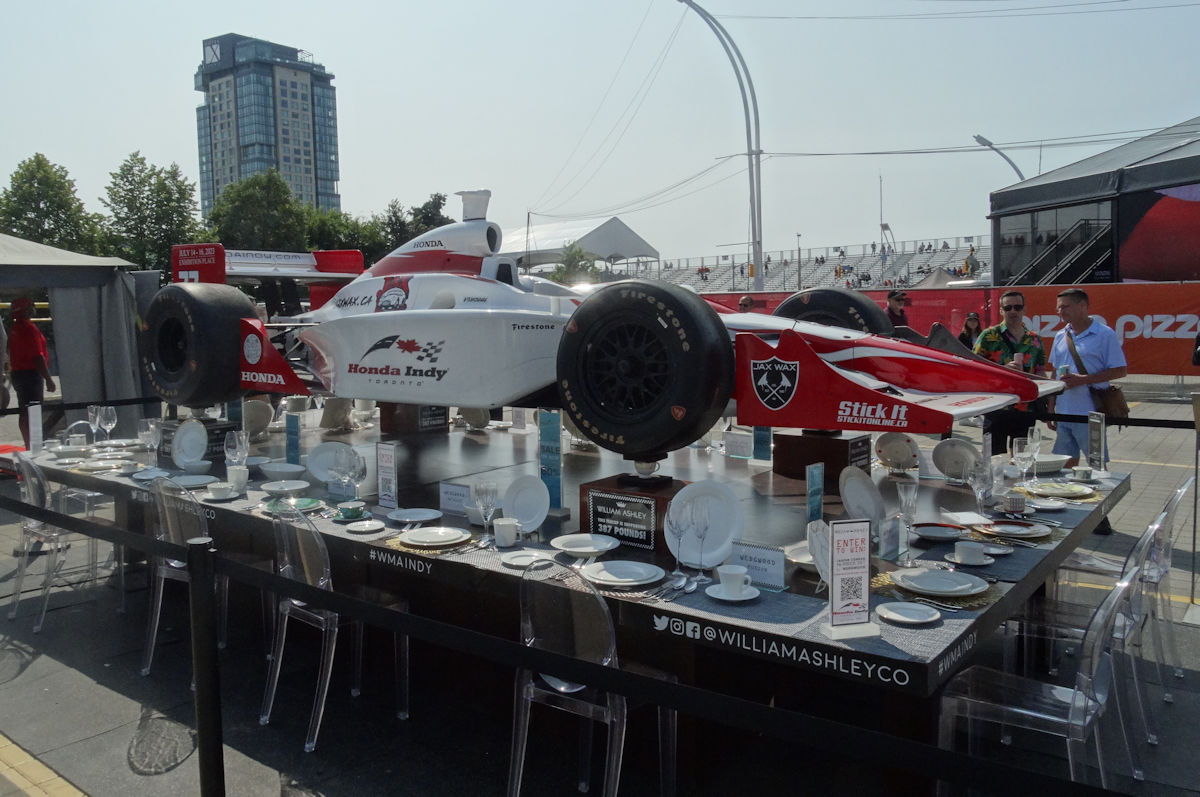 |
Robert Huffman Hero Card with White House Apple Juice Pontiac Sunfire
|
Years of Competition: 1975-2003
Notable Drivers: Dean Combs, Michael Waltrip, Davey Allison, Larry Caudill, Robert Huffman
As was many gasoline dependent industries during the 1970s, the 1973 oil crisis caused a deep impact to NASCAR. One of the most notable consequences of the situation was the 1974 Daytona 500 being cut by 50 miles. In the crisis, NASCAR explored a new racing tour tailored to the rapidly growing interest in the compact car sector in the United States. The solution presented itself in the form of the Baby Grand National Racing Association (BGNRA) that was assembled in June 26, 1973 with NASCAR adopting the series in April of 1975.
The race vehicles featured in the series were based on domestic and foreign production cars with single overhead cam four-cylinder engines. The Chevrolet Vega, Mercury Capri and Ford Pinto proved popular during the opening season. Other cars converted to compete in the early years of the Baby Grand National series included the Dodge Colt, Ford Mustang II and Opel Kadett. In the 1975 Jaycee 320 held at North Wilkesboro Speedway, a 1973 Saab was driven by Kenny Lindell finishing 13th place in the 38-car field.
 |
| Image from Program for 1975 Jaycee 320 Baby Grand Auto Race Program of #121 Larry Caudill and #21 Larry Pearson in Mercury Capris |
Car counts were robust for many of the NASCAR Baby Grand National Series in the first year with a healthy dose of young competitors. Larry Pearson, son of Cup Series champion David Pearson, was an early draw. Other drivers such as Larry Caudill and Dean Combs would build long reputations in the series right from its inception. 23-year-old Combs won the first championship in Baby Grand Nationals and went on to take the title in the next two years as well. Combs’ would finish as the winner for a record 60 races in the series competing between 1975 and 2002.
Focused in short tracks during its inaugural season, excursions to larger tracks such as the 1.017-mile North Carolina Motor Speedway (Rockingham) and the 1.5-mile Charlotte Motor Speedway were also undertaken. In 1979, the prominence of the Baby Grand National series grew when the opening round was held on the prestigious Daytona International Speedway. Mike Watts won the 100-mile event christening what would be a regular annual show for compact cars during Speed Week. Larry Hoopaugh won the Daytona race three consecutive times from 1980 to 1982. Mike Swain Sr captured the most total victories for a series driver at Daytona with four.
Though American automakers were prominent in the Baby Grand National series in much the same fashion as other NASCAR divisions, the prevalence of compact cars offered a legitimate opportunity for European and Japanese manufacturers to regularly compete. In 1977, George Thompkins won a race at Champion Speedway driving a Datsun becoming one of the earlier occasions a Japanese auto brand won an NASCAR sanctioned race.
NASCAR would change the name of the division to International Sedan in 1980. Dean Combs earned two more championships in 1980 and 1981 piloting a Datsun 200SX. Datsun/Nissan’s presence in the series faded shortly after Combs’ success with General Motors products taking a firm hold of competition. Through the 1980s and 1990s, most successful competitors selected the Pontiac Sunbird and later Sunfire. Called the Darlington Dash Series in 1983 and 1984, Daytona Dash Series as well as Charlotte/Daytona Dash Series were used through 1985 to 1989.
 |
| Larry Caudill Hero Card with Pontiac J2000 Race Car |
Michael Waltrip, long-competing Cup Series driver and brother to NASCAR Cup three-time champion Darrell Waltrip, claimed the 1983 title for the division that adopted the use of the Dash Series for the first time that season. Another member of a renowned racing family, Davey Allison ran a handful of Dash Series events in his formative years as he would ascend to the Cup Series. The son of NASCAR legend Bobby Allison had a series-high finish of 3rd place at the 200-mile race at Daytona in February of 1984. Winner of the 1986 NASCAR Dash Series championship, Hut Stricklin would join Michael Waltrip and Davey Allison in becoming a Cup Series regular. In addition to the Waltrip and Allison names being heard at some point during the series history was the Earnhardt name. Kerry Earnhardt, the eldest son of seven-time NASCAR Cup Series champion Dale Earnhardt, campaigned a #3 Chevrolet Cavalier through the 1993 season finishing eight times in the top ten over 11 race starts.
During the 1980s, the NASCAR Dash Series served as the stage for some historical moments for women in motorsports. From Yorktown Heights, New York, racer Karen Schulz’s performance in her freshman year of the Charlotte/Daytona Dash Series earned Rookie of the Year recognition. In the opening event for the 1988 season for the series, the Florida 200 at Daytona International Speedway finished with Schulz in 2nd place and series newcomer Shawna Robinson in 3rd place. In June of 1988, Robinson would be the first woman to win an NASCAR touring event when he won a 100-mile race at New Asheville Speedway and went on to claim the Charlotte/Daytona Dash Series Rookie of the Year in her season-long performance.
For 1992, Goody’s Headache Powder became the title sponsor for the Dash Series and carried their commitment through to the conclusion of the racing division. Following the gain of the title sponsor, the tour regularly received television coverage with a number of events airing on ESPN. Thanks to the increased television coverage of the series, one of the most bizarre crashes at Daytona was captured on film. In the 1994 Florida 200, Dave Stacy’s Ford Probe spun on the backstretch caught up in a multi-car accident. The car carried its momentum before hitting an embankment that launched Stacy into Lake Lloyd. Despite his damaged race car being partly submerged in the lake, Stacy was unharmed after the incident. In 1997, the one and only father/son championship duo was cemented in 1997 when Mike Swaim Jr won the title 12 years after his father claimed back-to-back season-ending trophies.
 |
| Robert Huffman's Toyota Celica 2002 Goody's Dash Car (Toyota Motorsports) |
A series centered on four-cylinder power, the NASCAR Goody’s Dash Series would shake up the performance potential of the 100-inch wheelbase race cars for the 1998 season. In addition to the existing 191 cubic-inch four-cylinder engine, a 268 cubic inch V-6 engine option. Four-cylinder Goody’s Dash Series were allowed to run 100 pounds less weight but the six-cylinder engine proved to be rapidly popular.
In 2000, Toyota Racing Development used the Goody’s Dash Series as a first step into NASCAR for what would become their eventual climb to the Cup Series in 2007. The Toyota Celica debuted with Eric Van Cleef in 2000 before the manufacturer expanded their effort by luring reigning series champion Robert Huffman the following year. Cam Strader won the 2001 Goody’s Dash title piloting a Mercury Cougar while Jake Hobwood took the 2002 crown in a Pontiac Sunfire.
Final season of the NASCAR Goody’s Dash Series occurred in 2003 with an eight-race schedule that wrapped with a 150-lap event on the infield oval at Atlanta Motor Speedway. Justin Hobgood won the final event while Robert Huffman grabbed a series-tying fifth championship (an honour shared with Dean Combs) before joining the Craftsman Truck Series the following year. Huffman’s championship was also the first for a Toyota Racing Development driver in NASCAR.
Instead of completely fading out, the Dash Series would survive one more season reverting back to its non-NASCAR sanctioned roots. An organization called IPOWER (International Participants of Winning Edge Racing) revived the competition format in 2004 featuring the same compact race cars and several drivers from the former series. The IPOWER Dash Series ran for one season before it transitioned into the ISCARS Dash Touring Series that operated with support from ASA (American Speed Association).
References:
NASCAR
Women in Racing by Michael Benson
https://www.thethirdturn.com/wiki/NASCAR_Dash_Series_Central
Ultimateracinghistory.com





















